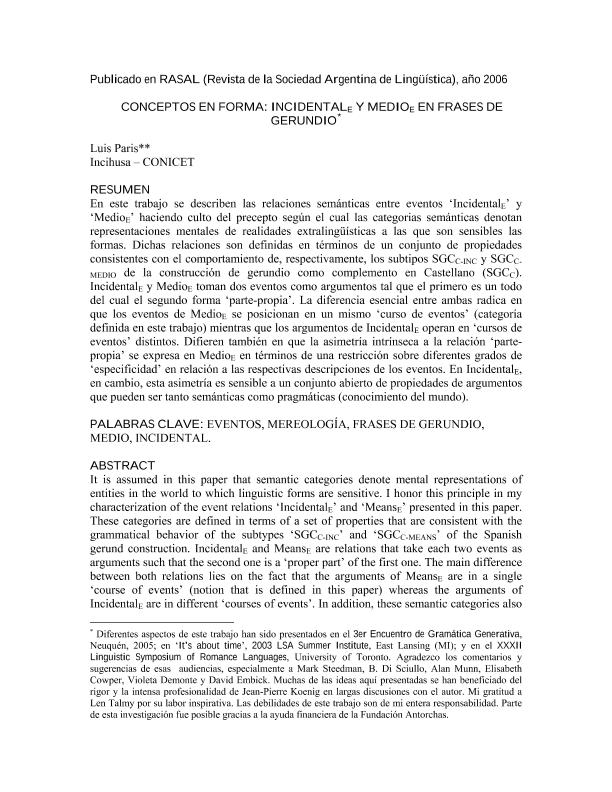Artículo
En este trabajo se describen las relaciones semánticas entre eventos ‘IncidentalE’ y
‘MedioE’ haciendo culto del precepto según el cual las categorias semánticas denotan representaciones mentales de realidades extralingüísticas a las que son sensibles las formas. Dichas relaciones son definidas en términos de un conjunto de propiedades consistentes con el comportamiento de, respectivamente, los subtipos SGCC-INC y SGCCMEDIO de la construcción de gerundio como complemento en Castellano (SGCC). IncidentalE y MedioE toman dos eventos como argumentos tal que el primero es un todo del cual el segundo forma ‘parte-propia’. La diferencia esencial entre ambas radica en que los eventos de MedioE se posicionan en un mismo ‘curso de eventos’ (categoría definida en este trabajo) mientras que los argumentos de IncidentalE operan en ‘cursos de eventos’ distintos. Difieren también en que la asimetría intrínseca a la relación ‘partepropia’ se expresa en MedioE en términos de una restricción sobre diferentes grados de ‘especificidad’ en relación a las respectivas descripciones de los eventos. En IncidentalE, en cambio, esta asimetría es sensible a un conjunto abierto de propiedades de argumentos
que pueden ser tanto semánticas como pragmáticas (conocimiento del mundo) It is assumed in this paper that semantic categories denote mental representations of
entities in the world to which linguistic forms are sensitive. I honor this principle in my
characterization of the event relations ‘IncidentalE’ and ‘MeansE’ presented in this paper. These categories are defined in terms of a set of properties that are consistent with the grammatical behavior of the subtypes ‘SGCC-INC’ and ‘SGCC-MEANS’ of the Spanish gerund construction. IncidentalE and MeansE are relations that take each two events as arguments such that the second one is a ‘proper part’ of the first one. The main difference between both relations lies on the fact that the arguments of MeansE are in a single ‘course of events’ (notion that is defined in this paper) whereas the arguments of IncidentalE are in different ‘courses of events’. In addition, these semantic categories also differ in that the intrinsic asymmetry of the proper-part relation surfaces in MeansE as a
constraint that requires different degrees of specificity to each of the event descriptions associated with the first and the second argument, respectively. In contrast, the asymmetry in IncidentalE is sensitive to an open set of either semantic or pragmatic restrictions (world knowledge) that is partially identified here.
Conceptos en forma: incidental y medio en frases de gerundio
Fecha de publicación:
12/2005
Editorial:
Facultad de Filosofía y Letras, UBA
Revista:
Revista de la Sociedad Argentina de Lingüística
ISSN:
0327-8794
Idioma:
Español
Tipo de recurso:
Artículo publicado
Clasificación temática:
Resumen
Archivos asociados
Licencia
Identificadores
Colecciones
Articulos(INCIHUSA)
Articulos de INST. DE CS. HUMANAS, SOC. Y AMBIENTALES
Articulos de INST. DE CS. HUMANAS, SOC. Y AMBIENTALES
Citación
Paris, Luis Alberto; Conceptos en forma: incidental y medio en frases de gerundio; Facultad de Filosofía y Letras, UBA; Revista de la Sociedad Argentina de Lingüística; 2; 12-2005; 47-70
Compartir




